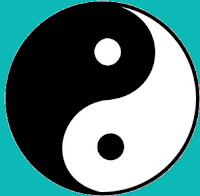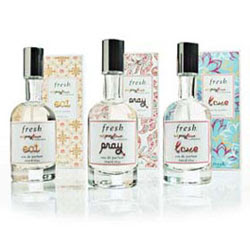 Prepare yourself. A tidal wave of Eat, Pray, Love merchandising is about to crash over America, from sea to shining sea.
Prepare yourself. A tidal wave of Eat, Pray, Love merchandising is about to crash over America, from sea to shining sea.Even if you have zero interest in eating mind-blowing food in Italy, experiencing enlightenment in India, or finding true love in Bali, you’d have to have been living in a cave for the past four years to be unaware of this book, which has more than five million copies in print and was on the New York Times bestseller list for over 155 weeks.
But if you did somehow manage to miss it, you’ll have many opportunities to learn about Eat, Pray, Love in the very near future. As the Huffington Post recently reported:
Eat, Pray, Love has a soundtrack, a home furnishings line, a clothing line, a jewelry line, a tour package that follows author Elizabeth Gilbert's itinerary across Italy, India, and Indonesia, a fragrance, a tea, and, for its piece de marketing resistance, an unprecedented three-day selling orgy on the Home Shopping Network, beginning Aug. 6, a week before the movie opens, of ‘more than 400 items across a variety of categories, including beauty, electronics, home decor, travel, cooking, jewelry, accessories, and ready-to-wear,’ including, as Variety reported this week, a line of lip glosses from Lancome, for whom Julia Roberts, star of the movie, is a spokesperson.
Wow. Even in America, that’s a marketing blitz of impressively ginormous proportions.
Still, it would be pretty unremarkable – just another Lion King or Batman-style movie-food-tchotchke-and-every-other-tie-imaginable marketing campaign – were it not for the fact that Eat Pray Love dovetails so neatly with the larger culture of American “feel-good spirituality” that we may be tempted to take its message of finding-one’s-true-self-through-adventurous-travel-in-exotic-lands seriously.
That is, instead of seeing it as a feel-good fantasy spiced with a generous sprinkling of “spirituality lite,” we might accept it as the story of genuine spiritual journey, an inspiring quest to find authentic meaning in life.
And that would be a mistake.
Don’t get me wrong. I’m not attacking Elizabeth Gilbert. She never presented herself as a spiritual teacher or pretended to be someone who she’s not. She’s a talented writer who expertly crafted a breakout bestseller, and deserves to reap the rewards of her work. Plus, I like .
The problem is not with Eat, Pray, Love itself, but with the larger culture. America traffics in so much ersatz, feel-good “spirituality” that it can be confusing, even damaging. Because the more that we buy into the belief that there’s easy answers to life’s most challenging questions, the more our strength to grapple with the multi-dimensionality of life – its joy as well as its inevitable pain – is diminished.
In her 2006 review, Jennifer Egan nicely captured the qualities that made Eat, Pray, Love so popular – and so remote from real life.
Lacking a ballast of gravitas or grit, the book lists into the realm of magical thinking: nothing Gilbert touches seems to turn out wrong; not a single wish goes unfulfilled. What's missing are the textures and confusion and unfinished business of real life, as if Gilbert were pushing these out of sight so as not to come off as dull or equivocal or downbeat. When, after too much lovemaking, she is stricken with a urinary tract infection, she forgoes antibiotics and allows her friend, a Balinese healer, to treat the infection with noxious herbs. ‘I suffered it down,’ Gilbert writes. ‘Well, we all know how the story ends. In less than two hours I was fine, totally healed.’Again, it’s not that Gilbert is to be faulted for telling a story in which every dilemma is quickly resolved with a nice, happy ending. The problem is that American culture encourages us to take this sort of magical thinking seriously. To believe that if we just think positively enough, become self-empowered enough, pray to Jesus enough, do yoga enough, eat organic enough, or do whatever the quick-fix that’s being sold to us today dictates enough, we’ll pretty quickly find ourselves healthy, happy, safe, fulfilled, beautiful, peaceful, and good. More or less forever.
And it’s just not true. There’s no quick-fix that will protect us from the painful dimensions of life. Even more importantly, spiritual practice is not meant to protect us from them.
On the contrary, it’s designed to give us the strength to open our hearts so fully to pain that they break open, allowing the light of compassion to flood in.
In this sense, pain and joy, darkness and light, suffering and spiritual growth are inextricably connected.
In a recent interview, Tricycle magazine asked the Buddhist teacher Yongey Mingyur Rinpoche, “If scientists could manipulate brain chemistry or use genetic engineering to increase happiness, would that be beneficial?”
“Maybe not so beneficial,” he replied. “Because suffering is the cause of happiness.”
Dr. Elisabeth Kubler-Ross wrote:
The most beautiful people we have known are those who have known defeat, known suffering, known struggle, known loss, and have found their way out of the depths. These persons have an appreciation, a sensitivity and an understanding of life that fills them with compassion, gentleness, and a deep loving concern. Beautiful people do not just happen.Of course, some Eat Pray Love fans will counter that this is precisely what that story is about. But I don’t buy it. (Although I do plan to see the movie, which looks really fun.) It just makes it all sound way too easy.
But of course, the story of a spiritual journey that explores the gut-wrenching dimensions of real life won’t work to sell perfume, home furnishings, and lip gloss.
In fact, if we spent more time learning from such stories, we wouldn’t feel the need to buy so much junk.
Feel-good spirituality all too easily merges into feel-good consumerism. And, if we’re honest with ourselves, we know that neither will keep us feeling good for very long.



16 comments: